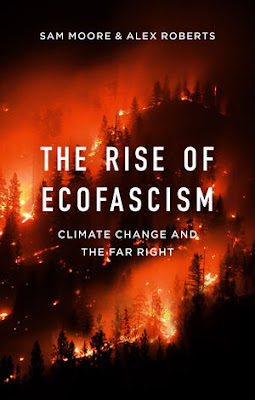By Matthew N Lyons
Threewayfight
August, 20th, 2023
Sam Moore and Alex Roberts, The Rise of Ecofascism: Climate Change and the Far Right
Cambridge, UK: Polity, 2022
160 pages; paperback $19.95, ISBN 9781509545384; hardback $59.95, ISBN 9781509545377
How are far rightists responding to the global climate crisis? Denial of climate change has long been an ingrained reflex among rightists far beyond the reach of fossil fuel industry propaganda. This is starting to shift as devastating heat waves, draughts, fires, and floods make the reality of global warming increasingly obvious–not as an impending danger but as a catastrophe that’s already well underway. Increasingly, sections of the right in North America and Europe are embracing environmental concerns but using them to bolster racism and exclusionary nationalism, tapping into traditions going back to the Nazis’ blood and soil ideology in Germany and the early conservation movement’s settler-colonialist underpinnings in the U.S. The racist mass murderers in Christchurch and El Paso four years ago both invoked environmental rationales, with the Christchurch shooter declaring himself an “eco-fascist.” Racist environmentalism may or may not clash with climate change denial, and some right-wingers, notably Tucker Carlson, have promoted both. One way or another, how far rightists address environmental issues is only going to become more important in the coming years, but what positions they will take and what impact it will have is not obvious.
An excellent entrée to this topic is The Rise of Ecofascism: Climate Change and the Far Right, by Sam Moore and Alex Roberts. This is one of the best books on far right politics that I’ve read in years. It offers an insightful overview of far right positions, past and present, on climate and environmental issues, and traces how conceptions of nature inform and underpin far right politics overall. Looking toward the future, The Rise of Ecofascism outlines several grim but believable scenarios for how far right environmental politics—and its relationship with capitalist interests—is likely to develop. The book honors the complexity of its subject without overwhelming the reader, and offers brief but helpful comments on the implications of the climate crisis for antifascist strategy.
“The Rise of Ecofascism offers an insightful overview of far right positions on climate and environmental issues, traces how conceptions of nature inform and underpin far right politics overall, and outlines several scenarios for how far right environmental politics—and its relationship with capitalist interests—is likely to develop.”
Moore and Roberts are well positioned to contribute to this discussion. From 2019 to 2022 the two of them hosted the UK-based radical antifascist podcast titled 12 Rules for What (a play on Jordan Peterson’s 12 Rules for Life), several of whose episodes have focused on environmental politics. Sam Moore left the podcast in 2022; since then, Alex Roberts has continued it solo. The Rise of Ecofascism is the second book they have co-authored. In 2021 Moore and Roberts published Post-Internet Far Right: Fascism in the Age of the Internet, which explores how the far right has changed in the era of online politics and culture.
Post-Internet Far Right set the stage for The Rise of Ecofascism in a number of ways. Both books demonstrate a wide-ranging familiarity with fascist and quasi-fascist politics, and both are written in a style that is intricate but clear and engaging. Both books also treat their subjects as arrays of multiple currents that interact dynamically and in complex ways. The following passage from Post-Internet Far Right encapsulates this approach and also highlights the thematic relationship between the two books:
“The types of far-right thought and action developing in the wake of the internet are much more varied and complex than these labels [“Nazi” and “fascist”] seem to indicate, and the type of thought and action that will predominate in the long-run has yet to be settled. The far right is in a state of productive diversification. It has yet to cohere around a new stable formulation; however, it almost certainly will, and we must be ready for it.”
* * *
“The various political forms [the far right] takes … are in tension with one another. Particularly, there is a tension between movement-building and deadly violence, or fascism in its ‘identitarian’ form and ‘blackpilled neo-Nazism. But this tension is not eternal. And the conditions under which these two halves might come back together and now also emerging, in the form of an ‘ecofascist’ politics that utilises global climate breakdown to justify murder. This ecofascism is not a homogenous movement, nor can it be, for it contains contradictory ideas of its own. Particularly, it will struggle to articulate the contradictions between ecology, ethnonationalism, and economic imperatives, like its historical forebears did. These contradictions are handles that anti-fascists can grasp to destroy it, but the scale and tactics of anti-fascism must be rethought…” (10-11).
In other ways, however, Moore and Roberts’s two books are quite different. Post-Internet Far Right was published by Dog Section Press, a small “anti-profit” anarchist publisher, while The Rise of Ecofascism was put out by Polity, an established academic press whose books are distributed by Wiley. Much of Post-Internet Far Right reads like an extended thought piece, with thought-provoking and often original analysis but little supporting documentation, while The Rise of Ecofascism delves into more specifics and cites a wide-ranging set of primary and secondary sources. Post-Internet Far Right focuses on explicating the far right’s dynamics, such as the radicalization process, use of memes, evolving organizational forms, and the complex relationships between leaders (or “influencers”) and the rank and file and between online politics and street activism. The Rise of Ecofascism, by contrast, focuses less on movement dynamics and more on the content and implications of far right ideas.
Despite its title, The Rise of Ecofascism isn’t just about a distinctive “ecofascist” movement or ideology but rather a broader range of racist and authoritarian environmental currents. Here and elsewhere, the book carries forward Post-Internet Far Right’s emphasis on multiplicity. After surveying an “episodic and disparate” history of far right environmentalisms, Moore and Roberts tell us that “the far right has diversified its nature politics once again, splintering into parts more or less accepting of the problem, more or less mystified, more or less ambivalent about the possible end of industrial modernity” (4). For example, some within the far right deny climate change altogether, some pay lip service to its reality but oppose constructive measures to address it, and some recognize the enormity of the climate crisis but want to solve it through authoritarian, supremacist, or genocidal means. Moore and Roberts trace these and other divergences across several sectors of the far right: governmental figures such as Donald Trump or Jair Balsonaro; political parties such as France’s National Rally or India’s Bharatiya Janata Party; non-electoral movements such as Italy’s Casa Pound, Identitarianism, and various offshoots of the alt-right; and individuals and groups that plan for or carry out acts of mass killing.
As in their first book, Moore and Roberts show a keen eye for complex dynamics. For example, while some on the left have simplistically presented neoliberalism and the far right as harmonious partners or branches of the same project, Moore and Roberts emphasize the contradictions involved:
“The dominant currents of contemporary far-right ecologism…work in a complex relationship to neoliberalism. They object to neoliberalism’s tendency towards international cultural homogenization, understood as social liberalization and the redress of structural disparities, as well as the homogenization of ‘nature.’ However, in response, they propose little else than the further radicalization of neoliberalization’s underlying drive toward privatization, this time lodged firmly at the scale of the national. We might suggest, given the seeming irreversibility of capitalism’s internationalization, that this is impossible. It is in facing this impossibility that the tendency towards violence might scale up” (51-52).
In The Rise of Ecofascism, the theme of multiplicity doesn’t only apply to the political realm but also the environmental one: just as the far right encompasses many distinct political threats beyond fascism, climate systems breakdown goes far beyond global warming to encompass a host of ecological problems, each interwoven with an array of societal causes and effects. The COVID-19 pandemic, which exploded just as Moore and Roberts started writing this book, is a prime example of an eco-crisis that can’t be reduced to global warming, and it shows some of the multi-sided ways that climate crisis plays out for human beings:
“Long imagined in disaster-movie style as a series of blazing hot summers and polar bears adrift, all punctuated by the occasional cataclysmic wave, it suddenly seemed to us that climate systems breakdown might actually look much more like the pandemic did: mass death events, sudden stresses on global supply chains, abrupt and previously unthinkable changes to everyday life, massive discrepancies in vulnerability across class and racial groups, a generally increased anxiety, racially displaced blame, the tightening of surveillance regimes… unprecedented measures that suddenly seem entirely necessary, the sudden collapse of livelihoods for billions of the world’s poor, and a deep economic shock worldwide” (2-3).
Being broader than the pandemic, Moore and Roberts note, “climate change [also] contains other kinds of crises: extreme weather events, migration crises, chronic and acute food and water shortages, climate-related conflicts and the like” (3).
The Rise of Ecofascism’s core argument, presented on Page 1, is that “the escalating climate crisis [will] provide opportunities to all parts of the far right.” This thesis is essentially predictive, and the book’s last chapter explores how environmental politics is likely to affect the far right’s future development and potential rise to power. In the coming years, Moore and Roberts argue, large numbers of mainstream rightists, particularly in the United States, will be forced to confront the fact that their leaders have lied to them about climate change, but rather than turning them into leftists, this realization is likely to drive many of them toward the far right through a combination of two reactions: “a revolt against those who have got us into this mess and simultaneously an attempt to hold on to what some people already have, either as individuals or, more worryingly, as racial groups” (5-6). Here Moore and Roberts are describing a double-edged anger which, I’ve argued elsewhere, is a key element fueling far right politics in general: people’s fear that their relative privilege or power is being challenged by oppressed groups below, coupled with a sense of being beaten down by political, economic, or cultural elites above.
In the context of multi-sided climate-fed crisis, Moore and Roberts envision the rise of large-scale nativist movements encompassing “a whole complicated mess of groups: conspiracists, authoritarians, denialists, nostalgists, China-hawks and admirers, cultural reactionaries and racists, anti-migrant activists and so on” (103). These movement could seek power in various ways, which the authors simplify down to three possible “projects” or “futures”:
- “Fossilized Reaction” – the nativist movement aligns with the fossil fuel wing of capital around a program of intensified climate denial and intensified militarization of society.
- “Batteries, Bombs and Borders” – the movement aligns with a broader array of capitalist interests that want to mitigate climate change by developing green energy technologies; to control the necessary resources (such as rare earth minerals) they pursue a new Cold War against China, boost authoritarianism at home, and deepen global inequities.
- “Climate Collapse Cults” – sizeable fractions of the nativist movement embrace a “logic of killing” that is currently espoused only by small fringe groups, and try to use mass murder to either end modern society or create enclaves cut off from it.
These scenarios will all have devastating consequences, but in different ways and with different implications for antifascist practice. The “Batteries, Bombs and Borders” scenario is particularly tricky, as it could attract large-scale support from liberal environmentalists.
Moore and Roberts discuss antifascist strategy in the book’s Conclusion. Echoing some of the arguments in their previous book, they urge antifascists to embrace tactical and strategic heterogeneity and to identify and exploit tensions and contradictions within the far right, for example “between the rural and the urban, statecraft and mass shootings, nihilism and spirituality, the needs of capital and the projected needs of the Volk” (129). Additionally, in a context where “all politics will, in one way or another, be climate politics” (128), antifascists and environmentalists need to learn from each other and embrace each others’ principles. But since environmentalism itself is a politically contested space, we need to “oppose ecologies of domination with ecologies of liberation” (136). That involves “resist[ing] those ideas of nature that are hierarchical, parochial, tied to a certain race or divided into essentially killable and unkillable parts” (130), but it also means challenging ideas of a common humanity that blame all humans equally for climate crisis or reduce solutions to individual responsibility, thereby masking systems of power.
“Since environmentalism itself is a politically contested space, we need to ‘resist those ideas of nature that are hierarchical, parochial, [or] tied to a certain race,’ but also challenge ideas that blame all humans equally for climate crisis or reduce solutions to individual responsibility, thereby masking systems of power.”
Given the authors’ solidly radical, anticapitalist perspective, it’s striking that they argue, echoing Christian Parenti, that “a resolution to the climate crisis must be built through the institutions that currently exist, because no others are possible to construct in sufficient time” (135). It’s hard for me to fault the logic here, but I would suggest a crucial caveat: any hope that existing institutions will craft a sustainable climate strategy depends on militant, independently organized popular pressure forcing them to do so.
My criticisms of this book are few. First, there is no index or bibliography, which makes the book harder to use because of the many political players discussed and works cited. Second, building much of the argument around political predictions, as Moore and Roberts do, risks making the book dated quickly, as events so often take unexpected turns. Maybe the point is to focus not so much on the specifics of the scenarios offered as on the insights that inform them: far right environmental politics (and capitalist responses to the climate crisis) could develop in a number of different ways, so we need to pay attention to multiple political currents, complex dynamics, and the dangers of trying to mitigate the crisis within the existing geopolitical framework.
A different kind of limitation is that the authors only address rightist currents whose politics centers on some form of racism or ethno-nationalism. This is customary in discussions of the far right but leaves out important religious-based movements, notably the Christian right, whose supremacist politics arguably centers on gender and sexuality rather than race. The Christian right is weak in Britain, but in the United States it’s huge, and major sections of it advocate a social and political transformation more sweeping than what many ethno-nationalist far rightists call for. Extending Moore and Roberts’s approach to look at how the Christian right relates to climate/environmental politics would be crucial for developing a comprehensive analysis and strategy.
Despite these issues, The Rise of Ecofascism is an outstanding contribution to discussions of both the contemporary far right and climate politics. It’s also testimony that some of the most thoughtful and nuanced analysis of fascism and related currents comes not from academia but from our movements.








